A cluttered fridge can make meal prep stressful and lead to wasted food. With limited space and various items to store, keeping everything neat and accessible often feels impossible. However, a well-organized fridge isn’t just visually appealing—it can save time, reduce waste, and even help you stick to healthier eating habits.
From clever storage solutions to space-saving hacks, there are countless ways to transform your fridge into a model of efficiency. Whether you’re dealing with a small appliance or a family-sized fridge, these top 20 organization ideas will help you maximize space, keep food fresh, and create a system that works for your household.
Maximize Space With Clear Bins
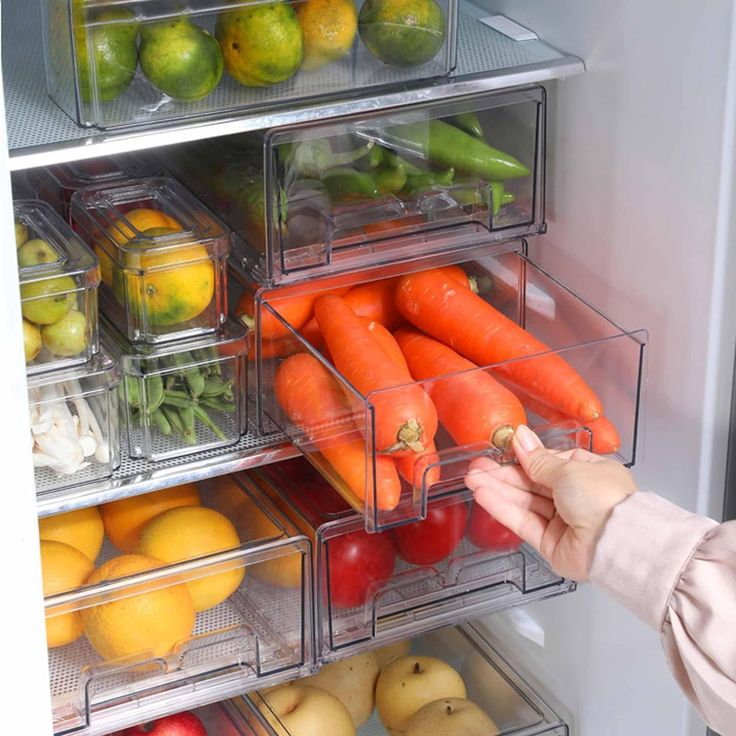
Using clear bins is a game-changer for fridge organization, making it easier to see and access everything. They help you create designated zones, ensuring efficient use of every inch of fridge space.
Choose Stackable Bins
Stackable bins maximize vertical space, especially in smaller fridges. They allow items to be grouped by category, such as fruits, vegetables, dairy, or snacks. With their stackable design, you can layer items while keeping them accessible—no more rummaging through cluttered shelves.
Choose bins with lids to maintain stability when stacked. For example, stack yogurt cups or condiments in separate bins to keep them neatly arranged. When selecting bins, opt for clear materials to quickly identify contents without opening them. These bins also fit well in fridge drawers, enhancing organization in underutilized areas.
Label Each Bin for Easy Access
Labeling bins streamlines your fridge routine by eliminating guesswork. Whether it’s “Produce”, “Snacks,” or “Leftovers,” labeled bins ensure every item has its place. This system helps others in your household maintain order too.
Use waterproof labels for durability and match fonts for a cohesive look. For example, label one bin “Cheeses” and another “Breakfast Ingredients” to simplify meal prep. By clearly marking bins, you’ll also prevent expired food from getting lost at the back of the fridge.
Group Similar Items Together
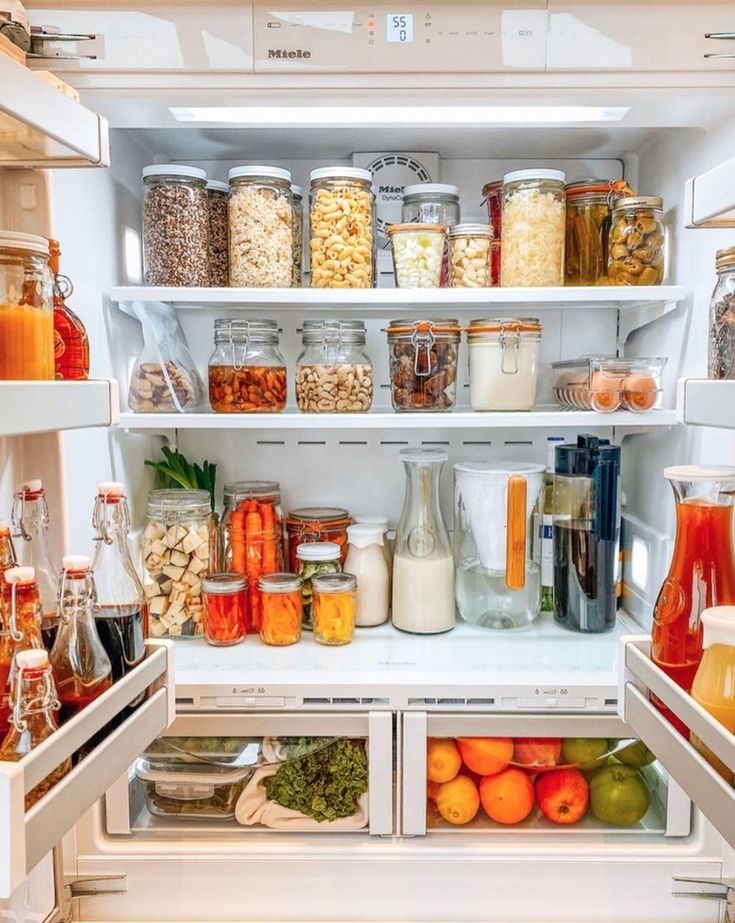
Grouping similar items together simplifies access and keeps the fridge orderly. By assigning zones for specific food categories, users can avoid losing track of perishable items.
Store Dairy Products in One Zone
Place all dairy products, such as milk, yogurt, butter, and cheese, in a single spot. Keeping them together in the fridge’s coldest area, often the middle or lower shelves, helps maintain their freshness longer. Utilize a clear bin or a designated section to prevent them from mixing with other items. Storing dairy in a fixed zone makes it easier to locate these essentials during meal prep and reduces the likelihood of expired products being overlooked.
Keep Snacks in a Separate Area
Dedicate a designated zone for snacks like string cheese, fruit cups, granola bars, and pre-packed treats. Use bins or containers to organize this space, especially if multiple family members access it. Reserve one shelf or zone for this category to encourage quick grab-and-go access. Keeping snacks separated ensures they’re easily visible, prevents them from cluttering other areas, and supports maintaining an overall organized fridge arrangement.
Use Lazy Susans for Accessibility
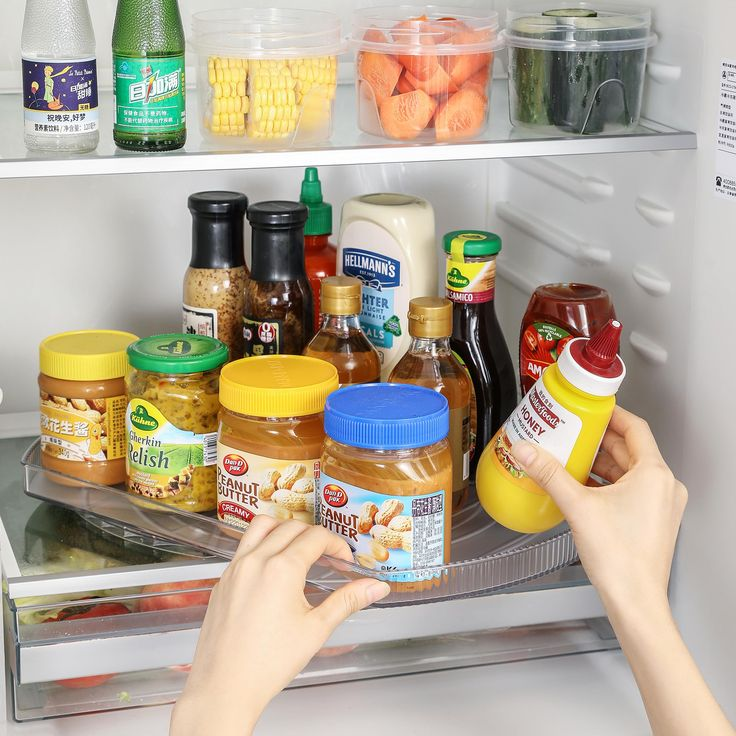
Lazy Susans are an excellent way to maximize fridge organization and improve accessibility. By using their rotating design, they make it easy to find and reach items stored at the back without having to rearrange everything.
Place Condiments on Lazy Susans
Store condiments on Lazy Susans to keep them organized and easy to access. Group similar items, such as salad dressings, sauces, and jars, onto one turntable to quickly locate what’s needed. This eliminates the hassle of digging through crowded shelves and prevents items from getting lost behind others. Opt for non-slip Lazy Susans to keep bottles securely in place. Their rotating function also allows you to maximize shelf space, as every item is visible and within reach.
Rotate Items to Avoid Wasting Food
Use Lazy Susans to regularly rotate items and prevent food waste. Place older products, like dairy or sauces nearing their expiration dates, toward the edge for quick retrieval. This system ensures that food is used before it expires. Lazy Susans also make it easier to spot duplicates, helping to avoid over-purchasing. Choose a two-tier model to separate items by category while maintaining clear visibility, further enhancing fridge organization and efficiency.
Adjust Shelves for Flexibility
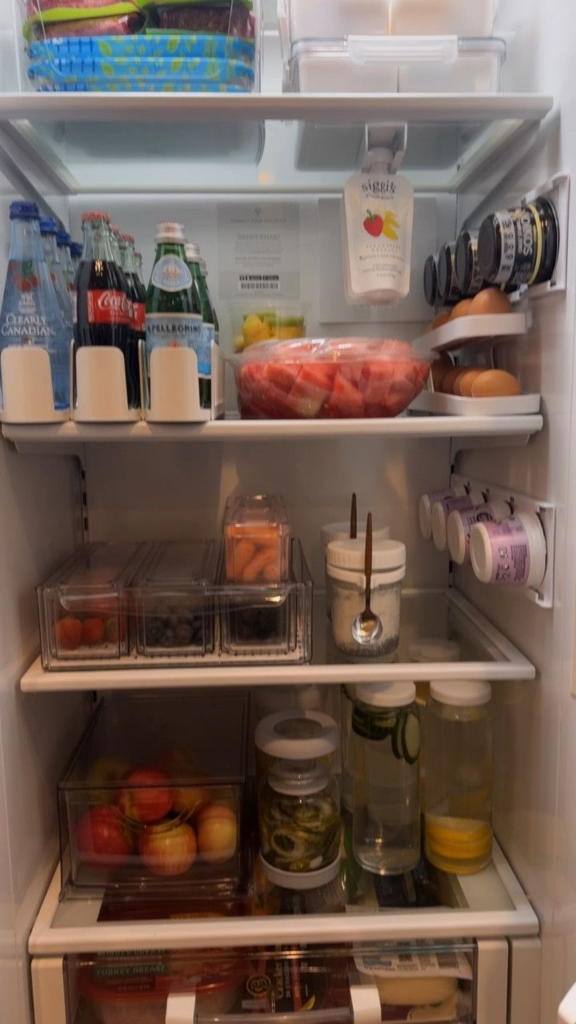
Adjustable shelves give users the power to tailor their fridge space as needed. This flexibility helps accommodate various items and maximize storage efficiency.
Create Taller Spaces for Bottles
Moving shelves can create extra space for taller bottles like milk, wine, or soda. Many fridges come with adjustable or removable shelves that can easily adapt to different heights. By repositioning one shelf, users can free up vertical space without cluttering the rest of the fridge.
Another option is dedicating a taller shelf section for items like water jugs or pitchers, ensuring they remain upright and prevent spills. Users can also place bottle organizers or slim racks on these shelves to keep bottles in place and avoid tipping. This setup optimizes storage space while maintaining order for grab-and-go convenience.
Lower Shelves for Short Items
Adjusting shelves lower can help when storing smaller items like yogurt cups, butter containers, or snack packs. It ensures that space isn’t wasted above shorter items, leaving room for bigger items elsewhere.
Lower shelves can also create smaller, dedicated sections for stackable containers. For example, smaller plastic organizers can group items like jams, dips, or baby food, preventing them from getting lost in the back. This strategy works particularly well when assigning sections for kids’ snacks or meal prepping ingredients, making them easy to access for quick use.
Use Drawer Dividers for Veggies
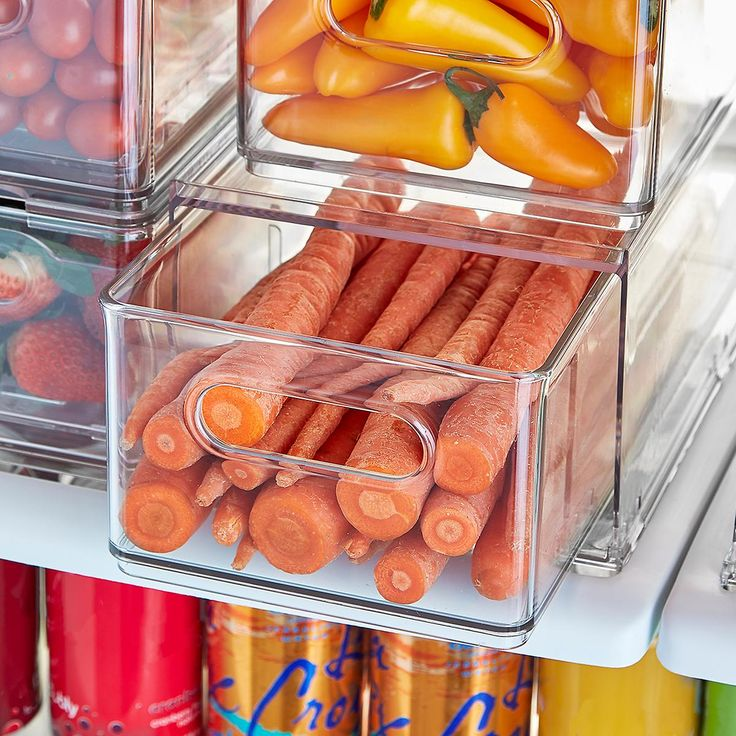
Drawer dividers are an effective way to organize fruits and vegetables in your fridge. They make it easier to categorize produce, reducing clutter and keeping foods fresher longer.
Separate Fruits and Vegetables
Separating fruits and vegetables in fridge drawers can prevent early spoilage. Many fruits, such as apples and bananas, release ethylene gas, which can cause nearby vegetables to ripen and spoil faster. Use drawer dividers to designate distinct sections for fruits and vegetables.
For example, one side of the drawer can hold leafy greens like spinach and lettuce, while another side is reserved for fruits like oranges and berries. This separation not only extends the life of your produce but also makes finding specific items quicker and more convenient. For added organization, group similar items together—for instance, keep root vegetables like carrots and radishes in one section and cucumbers or zucchini in another.
Keep Drawer Liners for Freshness
Keeping drawer liners in vegetable drawers helps maintain freshness and cleanliness. Moisture can build up in fridge drawers, causing produce to wilt or rot faster. Liners made of materials like silicone or washable fabric absorb excess moisture, keeping veggies crisp longer.
For example, leafy greens or herbs often retain water after washing, but a liner can wick away this moisture to keep them fresh. It also prevents messes caused by dirt or residue from root vegetables like potatoes. Choosing non-slip liners ensures items stay securely in place, reducing produce bruising during drawer movement. Liners are easy to clean, ensuring the fridge stays hygienic and odor-free while extending the life of your produce.
Invest in Vacuum-Sealed Bags
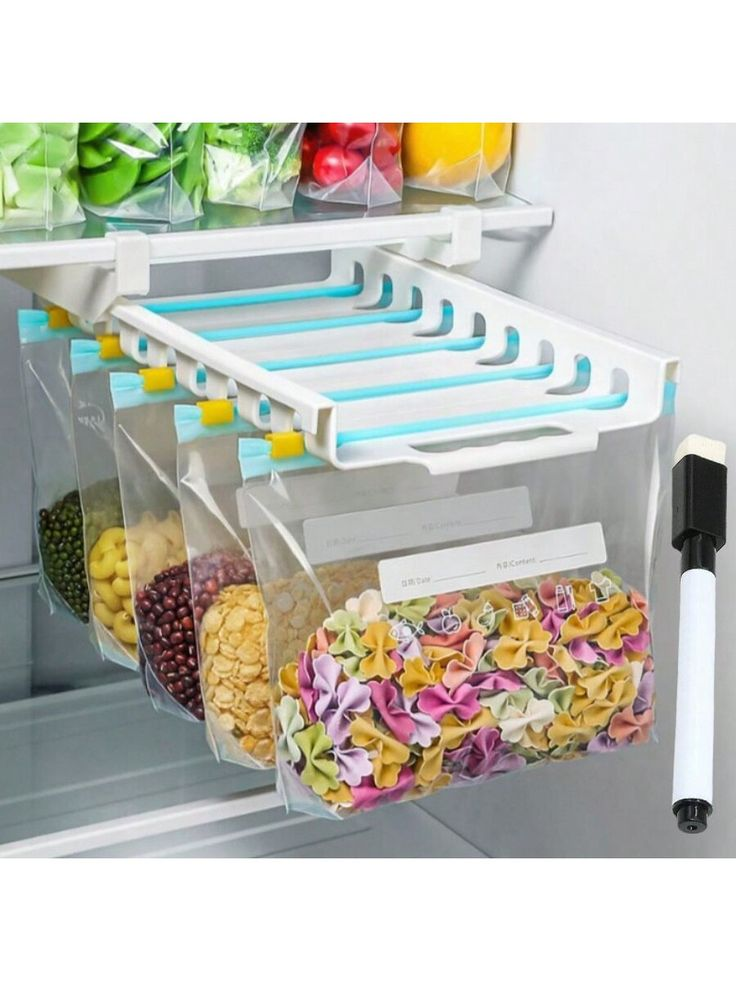
Vacuum-sealed bags are a game changer for fridge organization. They reduce clutter, optimize space, and help keep food fresh longer.
Save Space With Flat Packages
Vacuum-sealed bags help save space by creating flat, stackable packages. Unlike bulky containers, these bags tightly compress items, minimizing wasted space. They’re perfect for storing leftovers, meats, or pre-portioned meals, all while maintaining space efficiency.
Flat packages allow users to neatly stack or line up items in fridge compartments. For example, sealing raw chicken or marinated fish in flat layers ensures everything fits comfortably in drawers or shelves. This not only reduces clutter but also makes items easier to access at a glance. It’s a highly effective solution for small fridge spaces or households managing larger quantities of food.
Extend Food Shelf Life
Vacuum-sealed bags extend the shelf life of perishable items by removing air—one of the main culprits behind food spoilage. By eliminating oxygen, these bags slow bacterial growth, keeping items like raw meat, fruits, and vegetables fresher for longer.
For instance, sealing strawberries or spinach in vacuum-sealed bags can preserve their freshness up to twice as long compared to standard storage methods. They’re also great for freezing food, as the airtight seal prevents freezer burn. This technology ensures that both fresh and frozen items retain their quality, flavor, and texture, making it easier to eat healthy and reduce food waste.
Keep Meat in a Designated Section
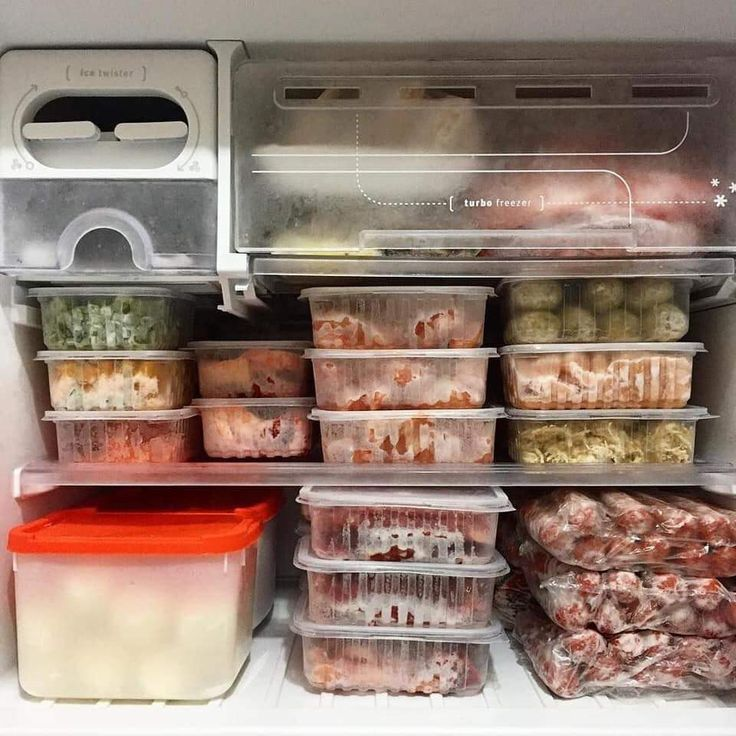
Storing meat correctly in the fridge is crucial for food safety and preventing contamination. Designate a separate area specifically for raw meat to keep other items clean and organized.
Use a Tray for Raw Meat
Using a tray to contain raw meat helps prevent leaks and spills from reaching other food items. Select a tray with raised edges to catch any liquids, keeping shelves free of mess. Opt for plastic or stainless steel trays since they’re easy to clean and resistant to bacteria.
Place the tray on the lowest shelf to minimize the risk of dripping onto other foods stored below. Assign it specifically for items like chicken, beef, or seafood to ensure organization and cleanliness. Regularly wash and sanitize the tray to maintain hygiene and prevent contamination.
Prevent Cross-Contamination
Preventing cross-contamination protects fresh produce and cooked food from harmful bacteria. Store raw meat separately, ideally in sealed containers or wrapped tightly in plastic before placing it on the tray.
Avoid storing meat alongside ready-to-eat foods like salads or dairy products. Clearly delineate space for each category and maintain consistent use of these zones. Check expiration dates frequently, removing outdated items to reduce risks and maintain a fridge that’s safe and well-organized.
Use Clear, Airtight Containers
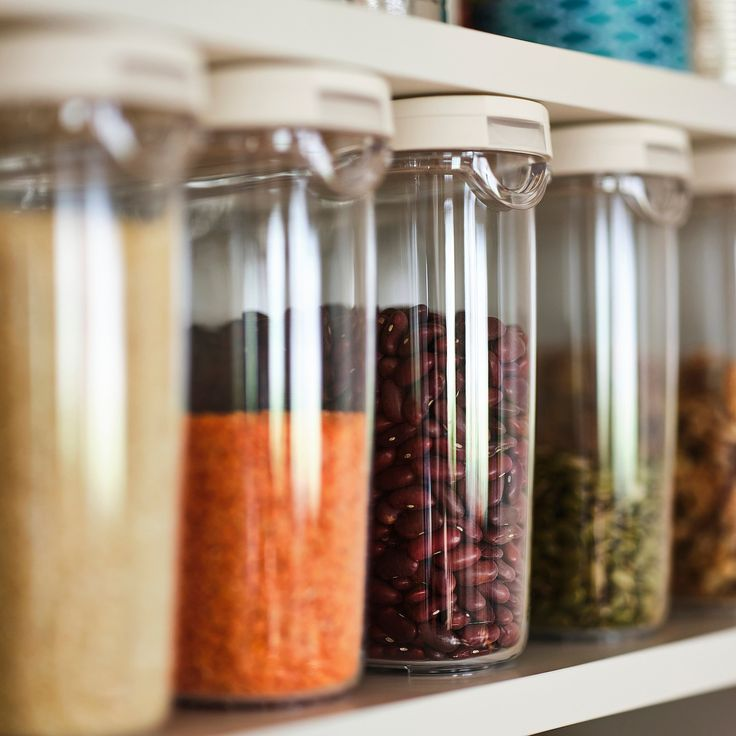
Using clear, airtight containers is a game-changer for fridge organization. These containers keep food fresh longer, reduce odors, and make it easy to identify items at a glance.
Store Leftovers Neatly
Store leftovers in clear, airtight containers to maintain freshness and prevent spills. Choose stackable designs to save space and keep the fridge looking tidy. For example, place leftover pasta, soups, or casseroles in uniform see-through containers so they’re easily recognizable and less likely to be forgotten.
Labels and dates on containers help track how long leftovers have been stored, avoiding spoiled food and waste. Position leftovers in a dedicated shelf or section near the front for quick access. This ensures they don’t get pushed to the back and overlooked during busy mealtimes.
Keep Fresh Produce Visible
Keep fresh produce in clear, airtight containers to extend shelf life while making fruits and vegetables easier to find. For example, store carrots, berries, or chopped melons in transparent containers to quickly spot what’s available without opening lids.
Position these containers in the middle or top shelves where they remain visible and at eye level. This placement encourages healthy eating habits by putting nutritious options front and center. Using stackable containers also prevents overcrowding and helps maintain airflow, improving produce freshness and overall organization.
Label Everything for Clarity

Proper labeling transforms fridge organization by eliminating guesswork and helping everyone easily locate items. It ensures each product has a designated spot, reducing clutter and waste.
Use Reusable Labels
Using reusable labels simplifies maintaining order in your fridge. They allow you to update categories or label new items without creating waste. Opt for laminated, chalkboard, or dry-erase labels to write down item names, ensuring clear identification. For example, label bins to distinguish between “Fruits”, “Vegetables”, and “Snacks”.
Reusable labels promote flexibility for changing storage needs. If your fridge layout changes or you switch storage containers, you can simply wipe and rewrite the labels to match. Place them on clear bins, shelf edges, or individual containers to streamline your system. A well-labeled fridge prevents misplaced items and makes everything easier to find.
Include Expiration Dates
Including expiration dates on labeled items reduces food waste and enhances safety. Write dates on food containers, leftovers, and clear bins to monitor freshness at a glance. For items like dairy or meal-prepped dishes, use erasable markers to write directly on resealable bags or airtight containers.
Grouping items with similar expiration dates helps prioritize usage. For instance, place older items toward the front using labels like “Use Soon” or “Expires XX/XX”. This practice ensures you consume perishables before they spoil, reducing waste and keeping your fridge well-organized. Date labeling also aids meal planning, saving time and preventing expired surprises.
Organize by Expiration Date
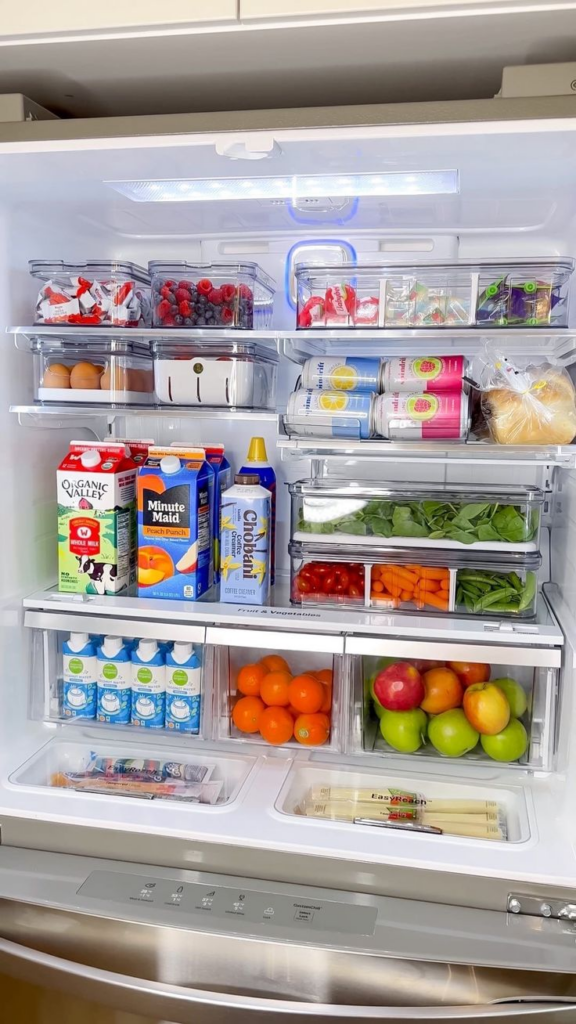
Organizing your fridge by expiration date helps prevent food waste and ensures you consume items before they spoil. Using this method keeps your fridge efficient and makes meal preparation more streamlined.
Push Older Items to the Front
Position older items at the front of each shelf to ensure they’re used first. This “first in, first out” (FIFO) method minimizes waste by making soon-to-expire products more visible and accessible. For example, if a yogurt container is nearing its expiration, moving it to the front means it’s more likely to be consumed before newer ones.
Group similar items, such as salad dressings or milk cartons, to create a clear distinction between older and newer products. Assign a dedicated section on each shelf for nearing-expiration foods, like leftovers or deli meats, so they’re easy to track. Use labels with clear expiration dates to help everyone in the household identify and prioritize these items. Regularly updating this system ensures no food is forgotten at the back of the fridge.
Place Recent Purchases Behind
Put newly purchased groceries at the back of the fridge to encourage consumption of older stock first. This practice reinforces the FIFO method, helping you maintain a steady rotation of perishable goods. Storing fresh eggs or dairy behind existing ones ensures you use the previously purchased items while they’re still good.
Positioning newer items behind older ones is especially effective when paired with labeled containers or bags. For categories like raw meats or precut vegetables, placing recent items further back creates visual cues for what needs to be used before buying more. Consistently applying this rule for all fridge items, including condiments and snacks, prevents clutter and promotes better organization. This habit leads to less waste, fresher meals, and a cleaner fridge.
Install Magnetic Racks or Clips
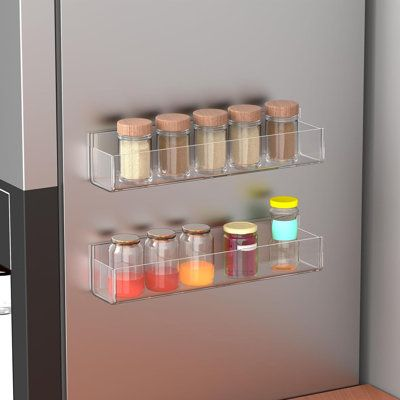
Magnetic racks and clips are excellent tools for making the most of unused fridge space. They take advantage of vertical and side surfaces, maximizing storage without cluttering shelves.
Hold Small Items Like Herbs
Magnetic racks are perfect for keeping small, delicate items like herbs neatly stored and within reach. By placing these racks on the interior walls or doors of the fridge, users can free up shelf space while ensuring herbs like cilantro, parsley, or mint remain easily accessible. These racks often come with small jars or containers that help preserve freshness, as they can be filled with water or lined with damp paper towels.
Magnetic spice jars can also double as herb holders, making them a multifunctional solution. For example, users can keep fresh thyme or rosemary in compact jars, preserving their flavor and extending shelf life. Herbs stored this way not only stay visible but also reduce the risk of being forgotten and going to waste.
Use Clips for Lightweight Packaging
Magnetic clips are ideal for securing lightweight packaging like snack bags, cheese wrappers, or even opened salad bags. By attaching them to the fridge’s side panels or underside of shelves, users can keep small, loose items organized and off the main shelves. This technique not only prevents clutter but also makes items like shredded cheese or baby spinach more visible and easily accessible.
Additionally, these clips are reusable and adjustable, allowing users to reposition them as necessary. For example, freezer bags of partially used fruits or veggies can be clipped and hung to save space while maintaining freezer airflow. Whether in the fridge or freezer, magnetic clips keep lightweight packaging upright and tidy, creating a more efficient and orderly storage system.
Freeze Extra Items Properly
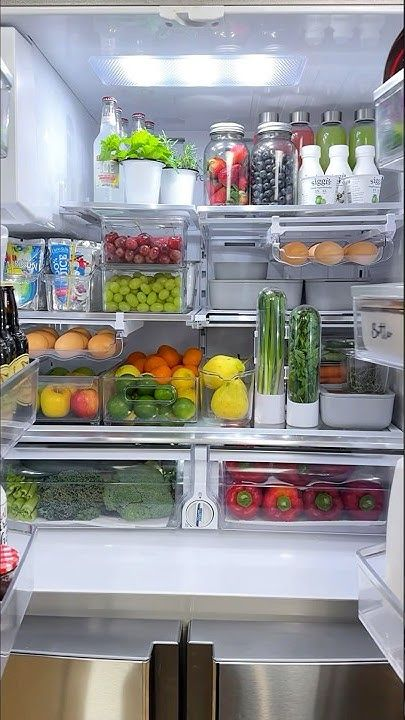
Freezing excess items correctly can save space and prevent food waste. Proper techniques ensure everything stays fresh and easy to access.
Flat Freeze Soups and Liquids
Flat freezing soups and liquids maximizes freezer space. Pour cooled liquids, like chicken broth or tomato soup, into freezer-safe bags, leaving some room for expansion. Lay them flat on a baking sheet to freeze, ensuring uniform, stackable portions.
Once frozen, store the flat bags upright in bins or on their edges like books to keep your freezer organized. This method makes it easy to see contents at a glance and retrieve specific items without rummaging. Label each bag with the date and contents for quick identification, reducing the chance of forgotten or wasted food. Flat freezing is ideal for meal-prepped soups, sauces, and stock.
Use Freezer Bags for Vegetables
Using freezer bags for vegetables preserves freshness and prevents freezer burn. Wash, dry, and chop veggies like carrots, broccoli, or bell peppers before placing them in these airtight bags. For best results, blanch vegetables first to retain their color, texture, and nutrients.
Flatten the bags to create space-efficient, stackable portions, storing them either flat or upright. Label bags with the date and name of the contents to track freshness and simplify meal prep. This technique is perfect for organizing prepped items for stir-fries, stews, or side dishes, ensuring your freezer stays tidy while extending the shelf life of your vegetables.
Keep a Regular Cleaning Schedule
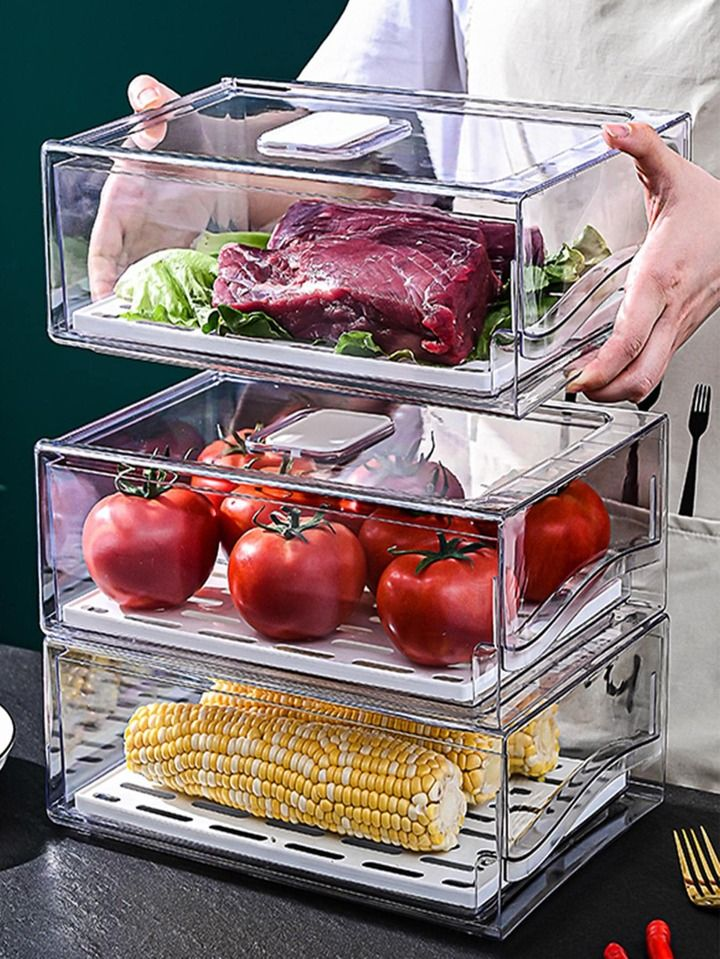
Maintaining a consistent cleaning routine ensures a hygienic and well-organized fridge. Regular cleaning prevents odors, reduces food waste, and keeps everything fresh and accessible.
Remove Expired Items Weekly
Checking for expired items every week keeps the fridge organized and safe for food storage. Discarding expired products like leftovers, dairy, or perishable snacks prevents unpleasant smells and frees up valuable space.
Designate a specific day, such as before grocery shopping, to inspect the fridge. Move older items to the front or near-expiration-only zones to prioritize their use. Keeping a weekly system ensures nothing gets overlooked and minimizes the chances of food waste while maintaining order.
Wipe Down Shelves Regularly
Cleaning shelves regularly prevents spills and stains from building up. Use a damp cloth or a mild cleaning solution to wipe down all surfaces, including shelves, drawers, and door compartments.
Focus on sticky spots caused by spills from condiments, juices, or dairy products. Removing crumbs or debris also prevents bacteria growth. Scheduling a cleaning session every 1-2 weeks keeps the fridge hygienic, ensuring a healthy environment while prolonging its efficiency.
Store Bottles With Bottle Organizers
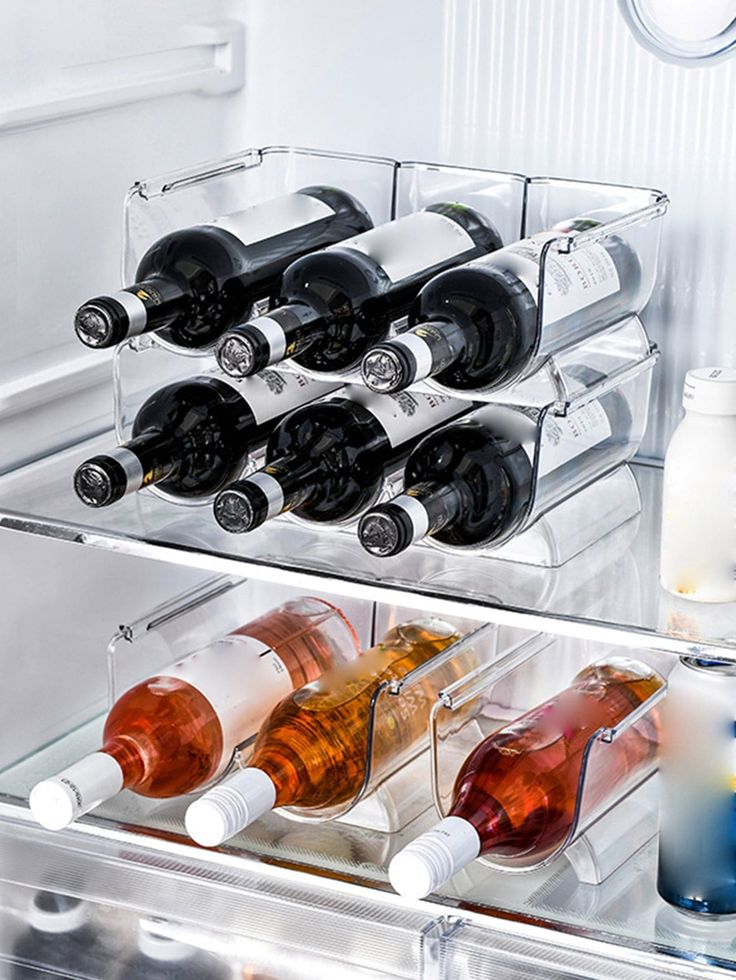
Keeping bottles organized in the fridge can often be a challenge. Bottle organizers offer a practical solution, ensuring efficient use of space while preventing spills and clutter.
Use Horizontal Wine Organizers
Horizontal wine organizers keep bottles secure and maximize space. These racks allow wine bottles to lie on their sides, ensuring the cork stays moist and the wine remains fresh. Designed for compact stacking, they prevent rolling and create a dedicated storage area for wine or similar items like sparkling water.
These organizers are versatile and can store olive oil bottles or sauces too. By grouping bottles horizontally, they free up vertical space for other tall items like milk cartons. They’re an excellent option for the bottom shelf, where the fridge’s colder temperature helps maintain optimal freshness for wine and beverages. Using a horizontal wine organizer can make any fridge look neat and sophisticated.
Add Tiered Racks for Smaller Bottles
Tiered racks are perfect for keeping smaller bottles like condiments, energy drinks, or mini juice containers visible and accessible. These racks typically have two or three levels, enabling users to arrange bottles by size or category, which minimizes clutter and saves space.
They fit well on fridge shelves and work particularly well for small areas. Clear designs make spotting items easy, while the tiered structure ensures nothing gets hidden at the back. Whether storing salad dressings, sauces, or baby bottles, tiered racks help create order. Adjustable options also allow users to customize as their storage needs change, improving fridge efficiency without compromising convenience.
Allocate a Snack Zone
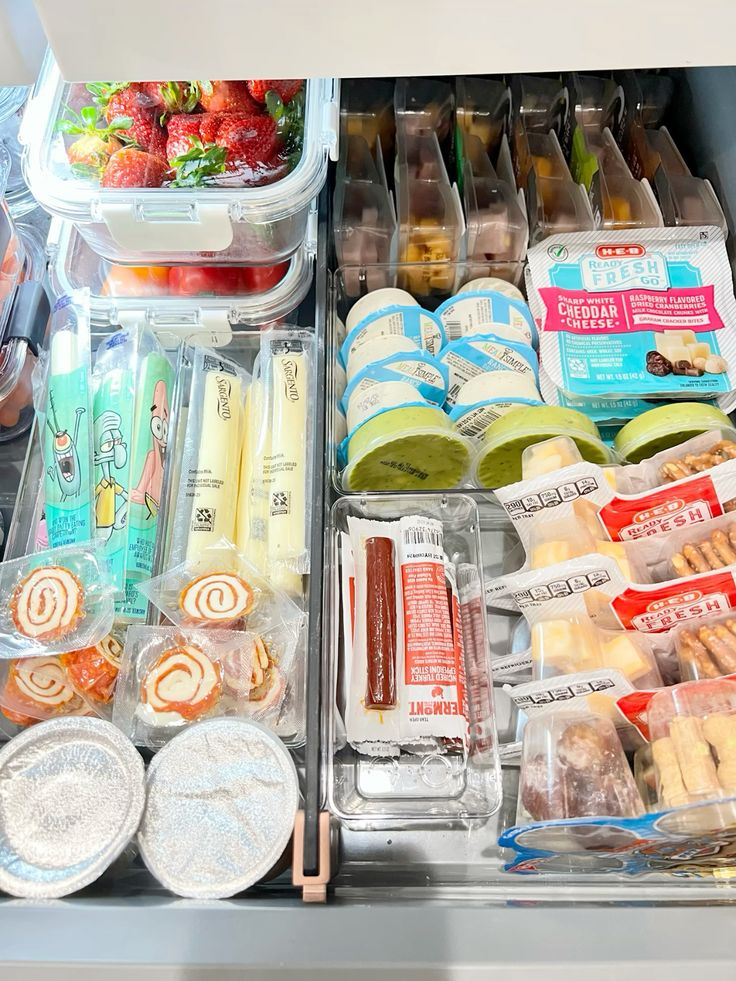
Creating a designated snack zone in your fridge simplifies access and keeps the space clutter-free. A well-organized snack area ensures everyone knows exactly where to find their go-to treats.
Use Small Clear Bins for Snacks
Utilize small clear bins to corral snacks and make them easy to locate. These bins are perfect for grouping similar items, such as cheese sticks, yogurt cups, or fruit pouches, into one convenient place. Their transparency allows family members to quickly see what’s available without rummaging through the fridge.
Choose stackable or narrow designs to save space while maintaining order. Labeling each bin with categories like “Healthy Snacks” or “Grab-and-Go” adds even more structure, making it easier to stick to your organization plan. With these bins, snacks remain visible, accessible, and neatly contained so they’re never forgotten or misplaced.
Install a Kid-Friendly Snack Section
Set up a kid-friendly snack section on a lower shelf or drawer to ensure easy access for little ones. Use small, durable containers to store pre-portioned snacks, such as cut-up fruits, mini veggie baggies, or individual packs of cheese. This approach promotes healthy eating habits and independence for kids.
Keep this area stocked with a mix of nutritious options and occasional treats to avoid kitchen meltdowns. Consider adding an adjustable bin or basket to organize items further while maintaining flexibility as their snack preferences evolve. By dedicating a kid-friendly snack zone, meal preparation becomes simpler, and kids learn responsibility over their choices.
Keep Herbs Fresher for Longer

Keeping herbs fresh can be tricky, but with the right methods, they can last significantly longer. Proper storage not only preserves their flavor but also reduces waste.
Use Herb Keepers or Jars
Storing herbs in herb keepers or jars extends their freshness by creating an ideal environment. Herb keepers have a built-in water reservoir to maintain just the right moisture level, keeping herbs like cilantro or parsley hydrated without over-soaking them. These containers also prevent exposure to excessive air, which can cause wilting.
For a simple DIY option, place herb stems in a small jar filled with an inch or two of water, similar to flower arrangements. Cover the tops with a loose plastic bag to trap humidity, securing it gently with a rubber band or string. This method works well for basil, mint, and other leafy herbs, making them accessible and fresh for longer periods.
Dampen Paper Towels for Storage
Wrapping herbs in damp paper towels helps retain moisture and prevents them from drying out. Lay a clean, slightly damp paper towel flat, place herbs like thyme or rosemary inside, and roll them gently to avoid crushing the leaves. Store the wrapped herbs in a breathable plastic bag or reusable silicone pouch to allow airflow.
This technique is particularly effective for delicate herbs like dill or chives, as it balances hydration without encouraging mold. Check the paper towel every few days, re-dampening if it feels dry. By maintaining just the right moisture level, this method can keep herbs vibrant a week or longer, reducing spoilage dramatically.
Plan Meals Around Your Fridge
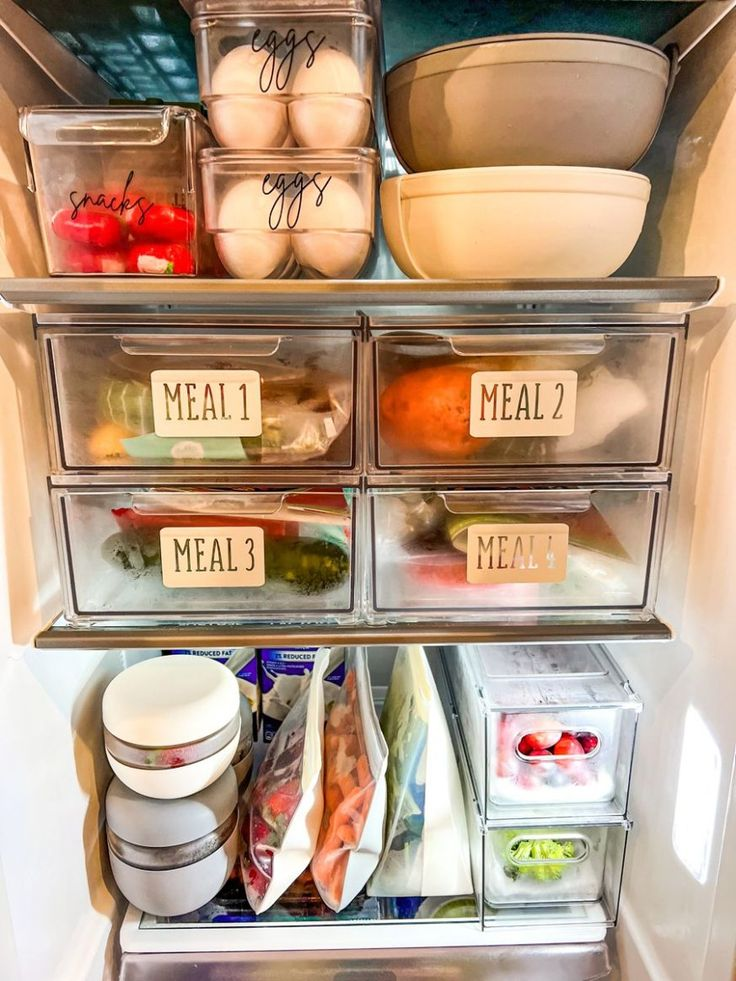
Meal planning becomes easier when the fridge is well-organized and ingredients are readily accessible. Structuring your fridge to align with your meal prep routine can save time and reduce food waste.
Organize Ingredients for Meal Prep
Grouping meal prep essentials together makes cooking effortless. Dedicate a specific shelf or bin for pre-chopped vegetables, marinated proteins, or pre-packaged ingredients that fit your weekly recipes. Arrange these items in clear containers or stackable bins for optimal visibility and easy access.
Keep quick-access items like yogurt, eggs, or salad greens within reach to simplify breakfast or quick meal planning. Place bottles of sauces and condiments regularly used in recipes, such as soy sauce or dressings, together in a small bin. This setup streamlines meal preparation and reduces the likelihood of forgetting key ingredients.
Reserve a separate section for ready-to-cook meals or ingredients that you’ve portioned out ahead of time. This not only saves time during busy days but also organizes your fridge for efficient use throughout the week.
Track What Needs to Be Used First
Prioritize using perishables by tracking their freshness. Keep older or near-expiry items at the front of fridge shelves to ensure they’re consumed first. Designate a labeled bin or zone for food that needs immediate attention, such as leftovers or produce approaching spoilage.
Use labels with dates to mark containers of prepped meals or opened items. This simple practice prevents waste and ensures no food goes unnoticed. For example, place opened tomato paste or half-used avocados in a clear, labeled container to promote awareness and encourage usage.
Implement a routine “use it up” day where meals are planned around items nearing expiration. This proactive approach not only saves money by avoiding spoiled food but also helps reduce unnecessary waste while keeping the fridge clutter-free.
Use Egg Holders for Safety
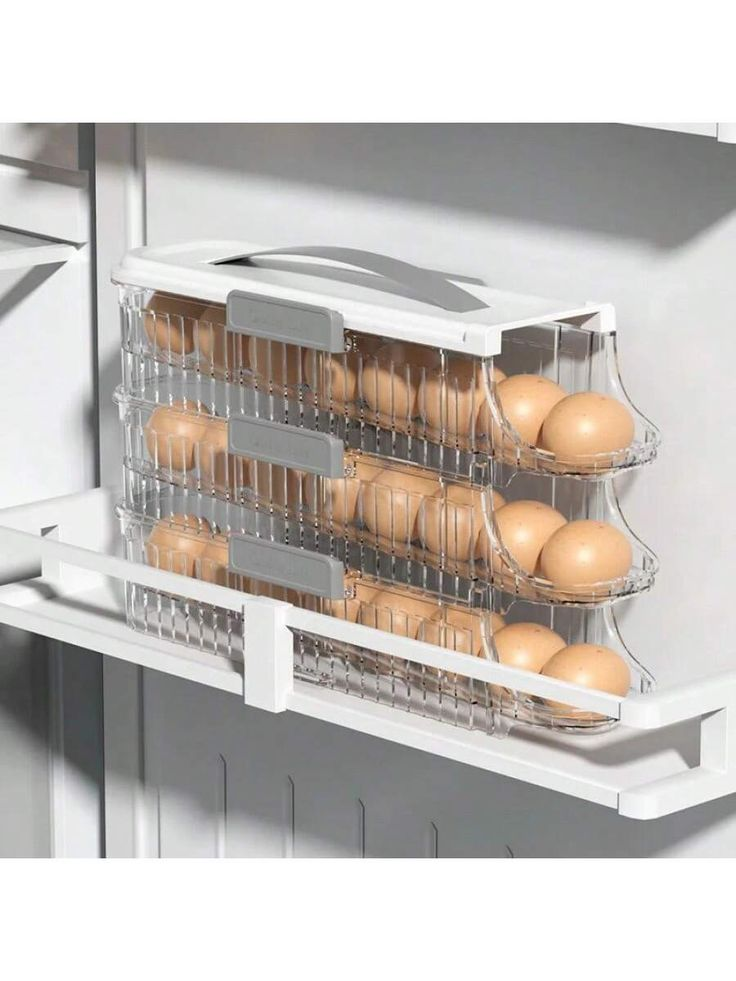
Egg holders are essential for preventing breakage and keeping eggs fresh in the fridge. Use these simple tools to optimize space and ensure safety.
Opt for Stackable Egg Organizers
Stackable egg organizers maximize vertical storage in the fridge while keeping eggs visible and safe. These clear containers are designed to hold eggs securely, reducing the risk of cracking compared to traditional egg cartons. Many stackable options feature lids, allowing you to store lightweight items, like butter or small condiments, on top without crowding the shelf.
Look for BPA-free, durable designs to ensure long-lasting use. Some organizers can hold up to 18 eggs, making them ideal for larger households. Stackable versions work perfectly in smaller fridges, where every inch counts, helping maintain an organized and clutter-free interior.
Keep Eggs Accessible and Secure
Place egg holders in a fridge area that’s cool and stable, such as a middle or lower shelf, rather than the door. This placement ensures consistent temperature, maintaining egg freshness. Secure designs in egg holders prevent rolling or accidental breakage, even when shelves are crowded.
Transparent egg trays also enhance visibility, making it easier to track how many are left at a glance. Consider using labeled organizers if storing different types, like free-range or organic eggs, to avoid confusion and streamline usage while cooking.
Dedicate A Shelf for Beverages
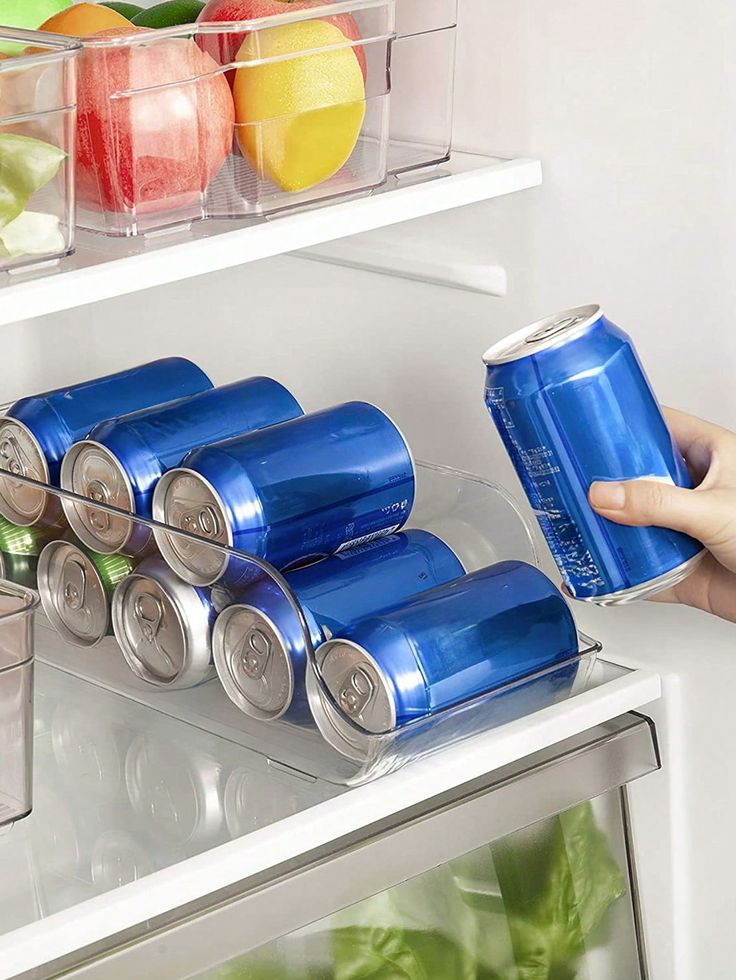
Designating a specific shelf for beverages ensures easy access and prevents bottles and cartons from cluttering other areas. This approach simplifies your fridge layout while maximizing efficiency for everyday use.
Use Can Dispensers for Drinks
Organizing canned beverages with can dispensers saves space and keeps them neatly aligned. These dispensers allow cans to roll forward as one is removed, ensuring that the oldest drinks are used first. Models with stacking capabilities further optimize vertical space, making them ideal for small fridges.
Store soda, sparkling water, or beer in a slim dispenser for better arrangement. For variety packs, consider dispensers with adjustable slots to group different flavors. Transparent dispensers let you quickly spot low stock, allowing for timely restocking. Placing these on a dedicated beverage shelf keeps drinks easy to reach while clearing space in other sections.
Group Milk and Juice Together
Assigning a section for milk and juice prevents misplaced cartons and reduces spills. Placing them side by side ensures quick access for breakfast or snacks. Use sturdy bins to hold lighter juice boxes and larger containers, avoiding tipping.
Opt for a lower-level shelf since these beverages are frequently used and can be heavy. Clear, labeled bins help differentiate items like almond milk, orange juice, or flavored milk. For families, color-coded labels simplify organization, ensuring kids and adults find what they need easily. This strategy keeps the fridge tidy and supports meal prep routines effectively.
Rethink Door Storage
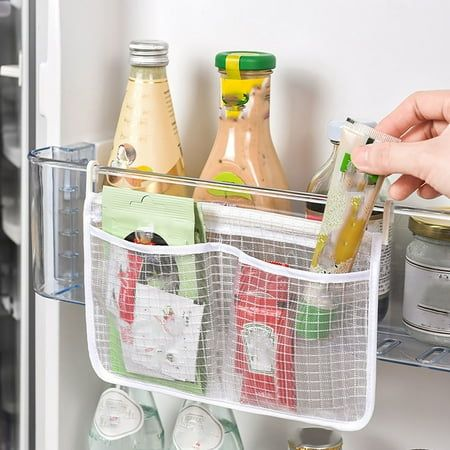
The fridge door is one of the most accessible yet underutilized spaces. By reorganizing it with purpose, it can become a powerful tool for maximizing storage and efficiency.
Place Condiments on Door Shelves
Storing condiments like ketchup, mustard, and salad dressings on the door shelves ensures easy access while reducing clutter in the main compartments. The door’s frequent movement suits items with high preservatives, as they’re less sensitive to temperature fluctuations compared to perishable goods. Group similar items together using small bins or organizers to keep sauces, dips, and other condiments tidy and secure. Use top shelves for lighter bottles and lower ones for bulkier condiments to balance weight and prevent tipping. Consider labeling sections to further streamline organization. By dedicating these shelves to condiments, they remain visible and within reach without crowding interior fridge space.
Keep Items Like Butter for Accessibility
The fridge door is ideal for storing butter, cream cheese, and jam since it’s easy to reach for breakfast and baking essentials. Butter compartments most commonly found in this area offer convenient storage, keeping spreads fresh and cool without taking up shelf or drawer space. Use a designated lidded bin for unwrapped butter sticks to ensure they stay clean while separating savory and sweet spreads for clarity. For families, reserving a specific section for these items helps limit misplacement and streamlines morning routines. These accessible storage solutions allow commonly used ingredients to stay organized and ready for use.
Conclusion
A well-organized fridge does more than just save space—it reduces stress, minimizes waste, and makes everyday life more efficient. By implementing creative storage solutions and thoughtful strategies, anyone can transform their fridge into a functional and visually pleasing space.
Whether it’s grouping similar items, using labeled bins, or maximizing vertical and door storage, these ideas ensure every item has its place. With regular maintenance and smart organization, keeping your fridge tidy becomes second nature, making meal prep and grocery planning a breeze.
